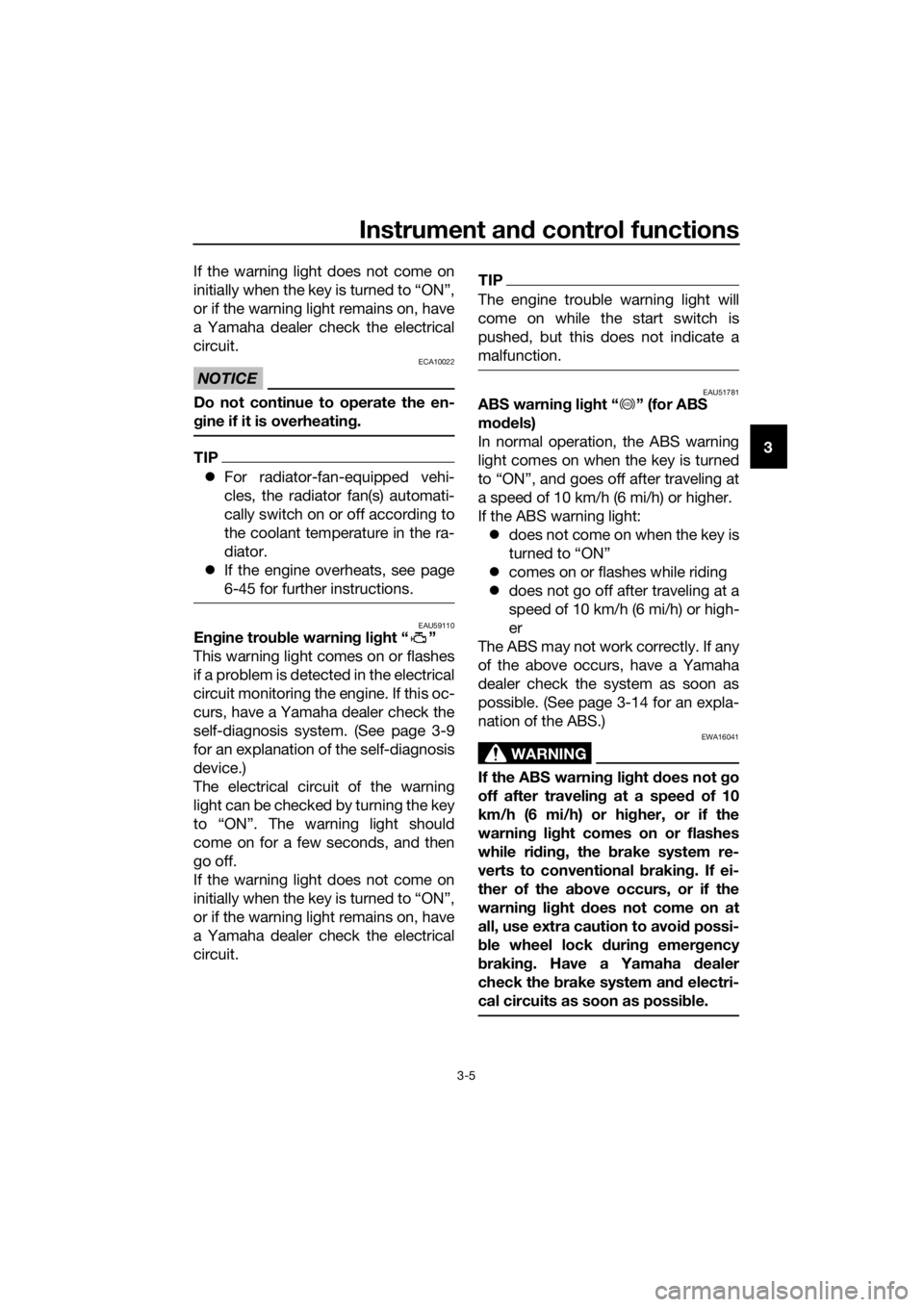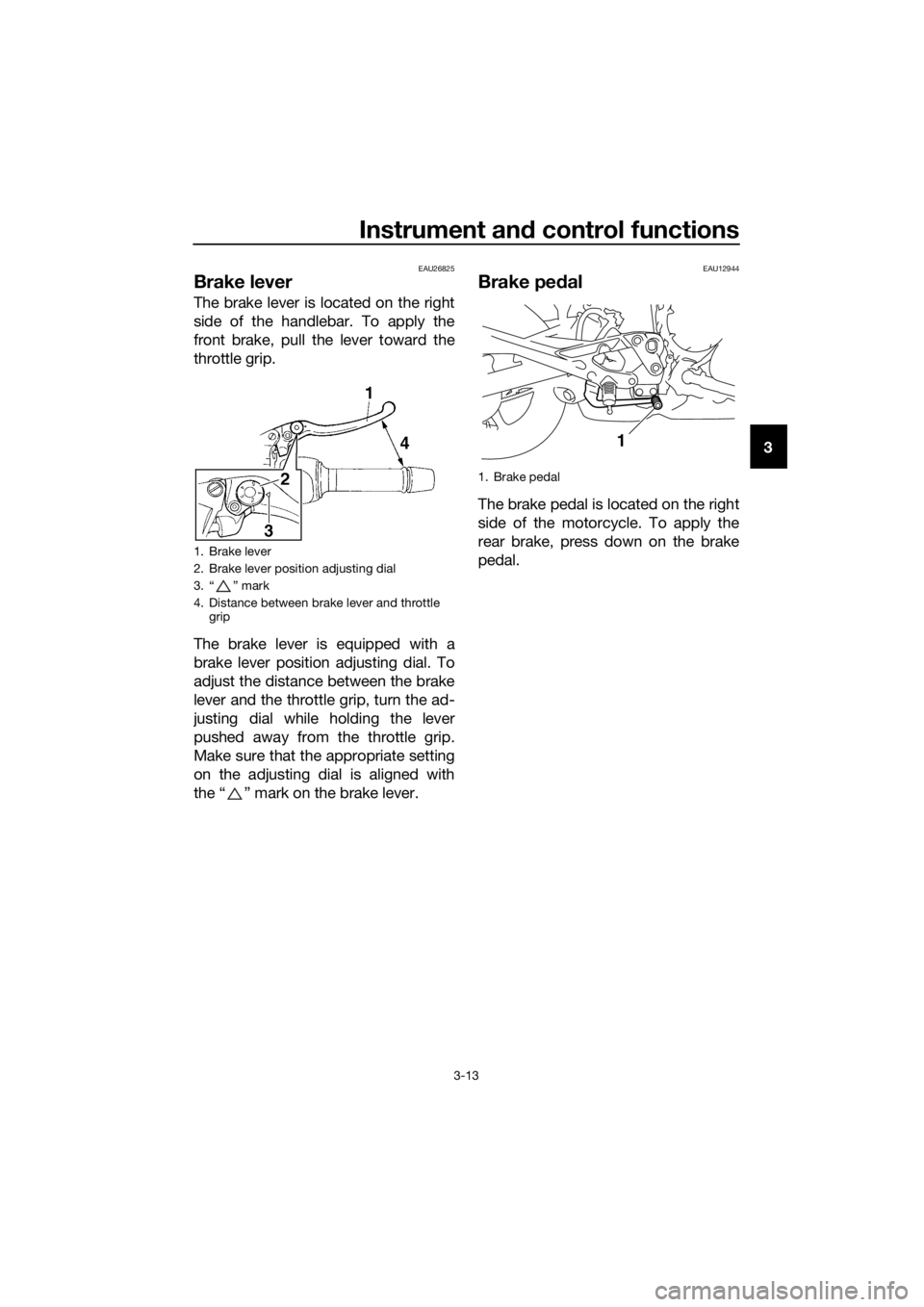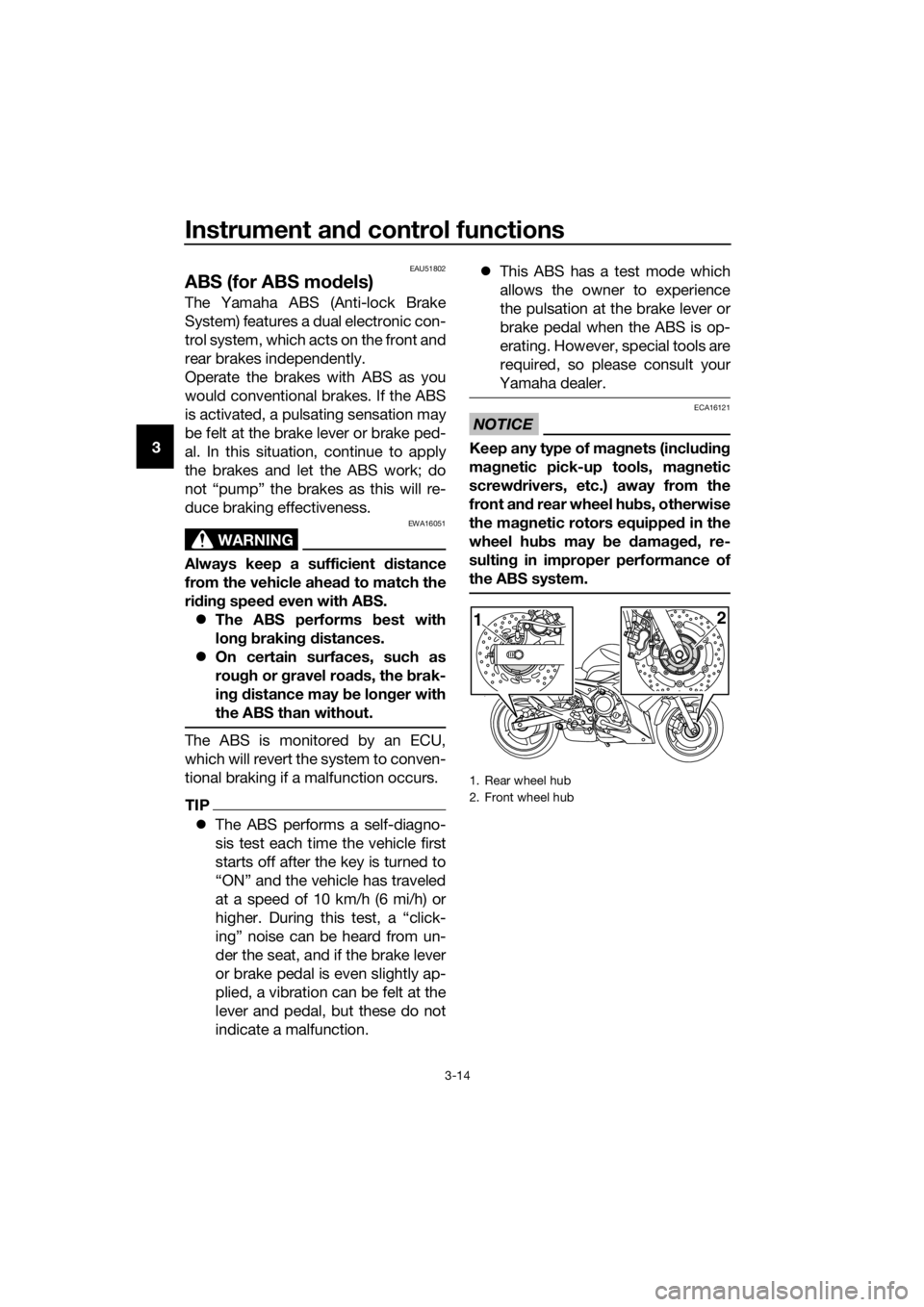brake YAMAHA XJ6F 2016 Owners Manual
[x] Cancel search | Manufacturer: YAMAHA, Model Year: 2016, Model line: XJ6F, Model: YAMAHA XJ6F 2016Pages: 104, PDF Size: 2.88 MB
Page 5 of 104

Table of contents
Safety information ............................1-1
Description ........................................2-1
Left view ..........................................2-1
Right view........................................2-2
Controls and instruments ................2-3
Instrument an d control functions ....3-1
Immobilizer system .........................3-1
Main switch/steering lock ...............3-2
Indicator lights and warning lights ............................................3-4
Multi-function meter unit .................3-6
Handlebar switches.......................3-10
Clutch lever ...................................3-12
Shift pedal .....................................3-12
Brake lever ....................................3-13
Brake pedal ...................................3-13
ABS (for ABS models) ...................3-14
Fuel tank cap.................................3-15
Fuel................................................3-15
Fuel tank breather hose and overflow hose.............................3-17
Catalytic converter ........................3-17
Seat ...............................................3-18
Helmet holder ................................3-19
Storage compartment ...................3-20
Handlebar position .......................3-20
Rear view mirrors ..........................3-21
Adjusting the shock absorber assembly....................................3-21
Sidestand ......................................3-22
Ignition circuit cut-off system........3-23
For your safety – pre-operation
checks ...............................................4-1
Operation an d important ri din g
points .................................................5-1
Starting the engine ..........................5-2
Shifting ............................................5-3
Tips for reducing fuel consumption ................................5-4
Engine break-in ...............................5-4
Parking ............................................5-5 Perio
dic maintenance an d
a d justment ........................................ 6-1
Owner’s tool kit ............................... 6-2
Periodic maintenance chart for the emission control system.............. 6-3
General maintenance and lubrication chart........................... 6-4
Removing and installing cowlings
and panels ................................... 6-7
Checking the spark plugs ............. 6-10
Engine oil and oil filter cartridge ... 6-11
Coolant ......................................... 6-14
Replacing the air filter element ..... 6-17
Adjusting the engine idling speed......................................... 6-19
Checking the throttle grip free play ............................................ 6-19
Valve clearance ............................. 6-20
Tires .............................................. 6-20
Cast wheels .................................. 6-23
Adjusting the clutch lever free play ............................................ 6-23
Checking the brake lever free
play ............................................ 6-24
Brake light switches ...................... 6-25
Checking the front and rear brake pads........................................... 6-25
Checking the brake fluid level....... 6-26
Changing the brake fluid............... 6-27
Drive chain slack ........................... 6-28
Cleaning and lubricating the drive chain ................................. 6-29
Checking and lubricating the cables ........................................ 6-30
Checking and lubricating the
throttle grip and cable ............... 6-30
Checking and lubricating the brake and shift pedals ............... 6-31
Checking and lubricating the brake and clutch levers ............. 6-31
Checking and lubricating the
centerstand and sidestand ........ 6-32
Lubricating the swingarm pivots... 6-32
Checking the front fork ................. 6-33
Checking the steering ................... 6-33
Checking the wheel bearings ....... 6-34
UBS1E0E0.book Page 1 Thursday, October 8, 2015 3:40 PM
Page 6 of 104

Table of contents
Battery .......................................... 6-34
Replacing the fuses ...................... 6-36
Replacing the headlight bulb........ 6-37
Auxiliary light bulb ........................ 6-38
Replacing the brake/tail light
bulb ........................................... 6-39
Replacing a turn signal light bulb ........................................... 6-39
Replacing the license plate light bulb ........................................... 6-40
Front wheel (for non-ABS
models) ..................................... 6-40
Rear wheel (for non-ABS models) ..................................... 6-42
Troubleshooting............................ 6-43
Troubleshooting charts................. 6-44
Motorcycle care an d stora ge.......... 7-1
Matte color caution ........................ 7-1
Care ................................................ 7-1
Storage ........................................... 7-4
Specifications ................................... 8-1
Consumer information ..................... 9-1
Identification numbers .................... 9-1
In dex ................................................ 10-1
UBS1E0E0.book Page 2 Thursday, October 8, 2015 3:40 PM
Page 13 of 104

Description
2-2
2
EAU63391
Right view
6
789 5
123 41011
1. Helmet holder (page 3-19)
2. Battery (page 6-34)
3. Rear brake fluid reservoir (page 6-26)
4. Engine oil filler cap (page 6-11)
5. Radiator cap (page 6-14)
6. Coolant reservoir (page 6-14)
7. Coolant drain bolt (page 6-15)
8. Engine oil dipstick (page 6-11)
9. Brake pedal (page 3-13)
10.Rear brake light switch (page 6-25)
11.Shock absorber assembly spring preload adjusting ring (page 3-21)
UBS1E0E0.book Page 2 Thursday, October 8, 2015 3:40 PM
Page 14 of 104

Description
2-3
2
EAU63401
Controls and instruments
12 3 56784
1. Clutch lever (page 3-12)
2. Left handlebar switches (page 3-10)
3. Main switch/steering lock (page 3-2)
4. Multi-function meter unit (page 3-6)
5. Front brake fluid reservoir (page 6-26)
6. Right handlebar switches (page 3-10)
7. Throttle grip (page 6-19)
8. Brake lever (page 3-13)
UBS1E0E0.book Page 3 Thursday, October 8, 2015 3:40 PM
Page 18 of 104

Instrument and control functions
3-4
3
EAU49398
In dicator li ghts and warning
li g hts
EAU11022Turn si gnal in dicator li ght “ ”
This indicator light flashes when a turn
signal light is flashing.
EAU11061Neutral in dicator li ght “ ”
This indicator light comes on when the
transmission is in the neutral position.
EAU11081Hi gh beam in dicator li ght “ ”
This indicator light comes on when the
high beam of the headlight is switched
on.
EAU11256Oil level warnin g li ght “ ”
This warning light comes on if the en-
gine oil level is low. The electrical circuit of the warning
light can be checked by turning the key
to “ON”. The warning light should
come on for a few seconds and then
go off.
If the warning light does not come on
initially when the key is turned to “ON”,
or if the warning light remains on after
confirming that the oil level is correct
(see page 6-11), have a Yamaha dealer
check the vehicle.
TIP
Even if the oil level is sufficient, the
warning light may flicker when rid-
ing on a slope or during sudden
acceleration or deceleration, but
this is not a malfunction.
This model is equipped with a self-
diagnosis device for the oil level
detection circuit. If a problem is
detected in the oil level detection
circuit, the oil level warning light
will flash repeatedly. If this occurs,
have a Yamaha dealer check the
vehicle.
EAU72930Coolant temperature warnin g
li g ht “ ”
This warning light comes on if the en-
gine overheats. If this occurs, reduce
the load on the engine immediately. If
message “HI” flashes in the coolant
temperature display, stop the vehicle,
then stop the engine and let the engine
cool.
The electrical circuit of the warning
light can be checked by turning the key
to “ON”. The warning light should
come on for a few seconds, and then
go off.
1. Turn signal indicator light “ ”
2. Immobilizer system indicator light
3. Neutral indicator light “ ”
4. High beam indicator light “ ”
5. Engine trouble warning light “ ”
6. Oil level warning light “ ”
7. Coolant temperature warning light “ ”
8. Anti-lock Brake System (ABS) warning light “ ” (for ABS models)
ABS
1 2 345
76
8
ABS
UBS1E0E0.book Page 4 Thursday, October 8, 2015 3:40 PM
Page 19 of 104

Instrument and control functions
3-5
3
If the warning light does not come on
initially when the key is turned to “ON”,
or if the warning light remains on, have
a Yamaha dealer check the electrical
circuit.
NOTICE
ECA10022
Do not continue to operate the en-
g
ine if it is overheatin g.
TIP
For radiator-fan-equipped vehi-
cles, the radiator fan(s) automati-
cally switch on or off according to
the coolant temperature in the ra-
diator.
If the engine overheats, see page
6-45 for further instructions.
EAU59110Engine trou ble warnin g lig ht “ ”
This warning light comes on or flashes
if a problem is detected in the electrical
circuit monitoring the engine. If this oc-
curs, have a Yamaha dealer check the
self-diagnosis system. (See page 3-9
for an explanation of the self-diagnosis
device.)
The electrical circuit of the warning
light can be checked by turning the key
to “ON”. The warning light should
come on for a few seconds, and then
go off.
If the warning light does not come on
initially when the key is turned to “ON”,
or if the warning light remains on, have
a Yamaha dealer check the electrical
circuit.
TIP
The engine trouble warning light will
come on while the start switch is
pushed, but this does not indicate a
malfunction.
EAU51781ABS warnin g lig ht “ ” (for ABS
mo dels)
In normal operation, the ABS warning
light comes on when the key is turned
to “ON”, and goes off after traveling at
a speed of 10 km/h (6 mi/h) or higher.
If the ABS warning light: does not come on when the key is
turned to “ON”
comes on or flashes while riding
does not go off after traveling at a
speed of 10 km/h (6 mi/h) or high-
er
The ABS may not work correctly. If any
of the above occurs, have a Yamaha
dealer check the system as soon as
possible. (See page 3-14 for an expla-
nation of the ABS.)
WARNING
EWA16041
If the ABS warnin g li ght does not go
off after travelin g at a speed of 10
km/h (6 mi/h) or hi gher, or if the
warnin g lig ht comes on or flashes
while ri din g, the b rake system re-
verts to conventional brakin g. If ei-
ther of the a bove occurs, or if the
warnin g lig ht does not come on at
all, use extra caution to avoi d possi-
b le wheel lock durin g emer gency
b rakin g. Have a Yamaha d ealer
check the brake system an d electri-
cal circuits as soon as possi ble.
ABS
UBS1E0E0.book Page 5 Thursday, October 8, 2015 3:40 PM
Page 27 of 104

Instrument and control functions
3-13
3
EAU26825
Brake lever
The brake lever is located on the right
side of the handlebar. To apply the
front brake, pull the lever toward the
throttle grip.
The brake lever is equipped with a
brake lever position adjusting dial. To
adjust the distance between the brake
lever and the throttle grip, turn the ad-
justing dial while holding the lever
pushed away from the throttle grip.
Make sure that the appropriate setting
on the adjusting dial is aligned with
the “ ” mark on the brake lever.
EAU12944
Brake pe dal
The brake pedal is located on the right
side of the motorcycle. To apply the
rear brake, press down on the brake
pedal.
1. Brake lever
2. Brake lever position adjusting dial
3. “ ” mark
4. Distance between brake lever and throttle
grip
1. Brake pedal
1
UBS1E0E0.book Page 13 Thursday, October 8, 2015 3:40 PM
Page 28 of 104

Instrument and control functions
3-14
3
EAU51802
ABS (for ABS mo dels)
The Yamaha ABS (Anti-lock Brake
System) features a dual electronic con-
trol system, which acts on the front and
rear brakes independently.
Operate the brakes with ABS as you
would conventional brakes. If the ABS
is activated, a pulsating sensation may
be felt at the brake lever or brake ped-
al. In this situation, continue to apply
the brakes and let the ABS work; do
not “pump” the brakes as this will re-
duce braking effectiveness.
WARNING
EWA16051
Always keep a sufficient distance
from the vehicle ahea d to match the
ri din g speed even with ABS.
The ABS performs best with
lon g b rakin g d istances.
On certain surfaces, such as
rou gh or g ravel roa ds, the b rak-
in g d istance may be lon ger with
the ABS than without.
The ABS is monitored by an ECU,
which will revert the system to conven-
tional braking if a malfunction occurs.
TIP
The ABS performs a self-diagno-
sis test each time the vehicle first
starts off after the key is turned to
“ON” and the vehicle has traveled
at a speed of 10 km/h (6 mi/h) or
higher. During this test, a “click-
ing” noise can be heard from un-
der the seat, and if the brake lever
or brake pedal is even slightly ap-
plied, a vibration can be felt at the
lever and pedal, but these do not
indicate a malfunction.
This ABS has a test mode which
allows the owner to experience
the pulsation at the brake lever or
brake pedal when the ABS is op-
erating. However, special tools are
required, so please consult your
Yamaha dealer.
NOTICE
ECA16121
Keep any type of mag nets (includin g
ma gnetic pick-up tools, ma gnetic
screwd rivers, etc.) away from the
front an d rear wheel hu bs, otherwise
the ma gnetic rotors equippe d in the
wheel hu bs may be damag ed , re-
sultin g in improper performance of
the ABS system.
1. Rear wheel hub
2. Front wheel hub
12
UBS1E0E0.book Page 14 Thursday, October 8, 2015 3:40 PM
Page 39 of 104

For your safety – pre-operation checks
4-1
4
EAU63440
Inspect your vehicle each time you use it to make sure the vehicle is in safe oper-
ating condition. Always follow the inspection and maintenance procedures and
schedules described in the Owner’s Manual.
WARNING
EWA11152
Failure to inspect or maintain the vehicle properly increases the possibility
of an acci dent or equipment d amage. Do not operate the vehicle if you fin d
any prob lem. If a pro blem cannot be corrected b y the proce dures provi ded
in this manual, have the vehicle inspecte d b y a Yamaha d ealer.
Before using this vehicle, check the following points:
ITEM CHECKSPAGE
Fuel • Check fuel level in fuel tank.
• Refuel if necessary.
• Check fuel line for leakage.
• Check fuel tank breather hose and overflow hose for
obstructions, cracks or damage, and check hose con-
nections. 3-15,
3-17
En gine oil • Check oil level in engine.
• If necessary, add recommended oil to specified level.
• Check vehicle for oil leakage. 6-11
Coolant • Check coolant level in reservoir.
• If necessary, add recommended coolant to specified
level.
• Check cooling system for leakage. 6-14
Front brake • Check operation.
• If soft or spongy, have Yamaha dealer bleed hydraulic
system.
• Check brake pads for wear.
• Replace if necessary.
• Check fluid level in reservoir.
• If necessary, add specified brake fluid to specified level.
• Check hydraulic system for leakage. 6-25,
6-26
Rear brake • Check operation.
• If soft or spongy, have Yamaha dealer bleed hydraulic
system.
• Check brake pads for wear.
• Replace if necessary.
• Check fluid level in reservoir.
• If necessary, add specified brake fluid to specified level.
• Check hydraulic system for leakage. 6-25,
6-26
Clutch • Check operation.
• Lubricate cable if necessary.
• Check lever free play.
• Adjust if necessary. 6-23
UBS1E0E0.book Page 1 Thursday, October 8, 2015 3:40 PM
Page 40 of 104

For your safety – pre-operation checks
4-2
4
Throttle grip • Make sure that operation is smooth.
• Check throttle grip free play.
• If necessary, have Yamaha dealer adjust throttle grip
free play and lubricate cable and grip housing. 6-19,
6-30
Control ca bles • Make sure that operation is smooth.
• Lubricate if necessary.
6-30
Drive chain • Check chain slack.
• Adjust if necessary.
• Check chain condition.
• Lubricate if necessary. 6-28,
6-29
Wheels an d tires •Check for damage.
• Check tire condition and tread depth.
• Check air pressure.
• Correct if necessary. 6-20,
6-23
Brake an d shift pe dals • Make sure that operation is smooth.
• Lubricate pedal pivoting points if necessary. 6-31
Brake an d clutch le-
vers • Make sure that operation is smooth.
• Lubricate lever pivoting points if necessary.
6-31
Centerstan d, si de-
stan d • Make sure that operation is smooth.
• Lubricate pivots if necessary.
6-32
Chassis fasteners • Make sure that all nuts, bolts and screws are properly
tightened.
• Tighten if necessary. —
Instruments, li ghts,
si gnals an d switches • Check operation.
• Correct if necessary.
—
Si destan d switch • Check operation of ignition circuit cut-off system.
• If system is not working correctly, have Yamaha dealer
check vehicle. 3-22
ITEM
CHECKSPAGE
UBS1E0E0.book Page 2 Thursday, October 8, 2015 3:40 PM